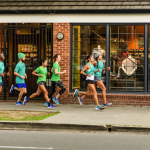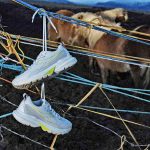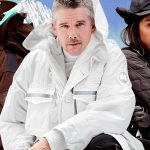According to preliminary figures released just prior to press time, total attendance at the recently concluded Interbike show in Las Vegas exceeded 22,000 – an increase of almost 4% over last years show. A breakdown of that figure reveals that there were slightly more than 11,000 buyers, up roughly 6.5% from the 2006 show. Unique retail businesses at the event numbered close to 3,800, a 17% increase compared to last year. The two-day Outdoor Demo held at Bootleg Canyon prior to the main indoor show boasted sunny skies, moderate temperatures and a relocated and expanded 65,000-square-foot site populated by 140 exhibitors – up from last years 130 exhibitors. This years total Demo attendance was estimated to be in the 5,500 to 6,000 range.
On the main show floor, one trend in particular stood out: the growth of the urban/commuter bike market and its growing influence in the greater sporting goods realm. Widespread consumer concern regarding the environment and rising fuel costs, coupled with the rising popularity of utilitarian, crossover bike/urban fashion, is being manifested as a growing interest in human-powered, urban transportation.
Call it a fixie fixation. Fixed gear bikes, which are relatively inexpensive and easy to build and maintain, have long been embraced by bike messengers and are now in demand by eco-conscious bicycle commuters, cash-strapped students and style-conscious urbanites. Think practical, simple and inexpensive. Adding to the appeal is the fact that a single-gear bike with no brakes is less enticing to would-be thieves.
While purists prefer to scavenge old steel frames and build them up with inexpensive, basic parts (a nod to the broader Do It Yourself and customization trends), many major bike makers-including Bianchi, Swobo, Redline, Surly, Specialized and Giant-now offer complete fixies for more discerning or less mechanically inclined consumers.
Just as significantly, the urban/retro appeal of bike messenger culture has spawned a booming apparel and accessories business that is now flowing into the mainstream sporting goods channel. In terms of apparel, this translates to a rapidly increasing selection of bike/urban crossover garments like eco-friendly Merino wool jerseys and outerwear in both retro and modern styles; multi-pocketed cycling capris, knickers and long shorts; and fully functional, streamlined jackets boasting performance materials and features that dont scream “bike geek” when worn to a bar or café.
On the accessory side, the urban bike trend is boosting the visibility of core messenger bag brands like Timbuk2, Chrome and Crumpler, and is beckoning newcomers – most notably, Rickshaw Bagworks, a start-up launched a few months ago by former Timbuk2 execs.
Also prevalent at Interbike was an increased focus on the triathlon market. In an effort to broaden their appeal among serious athletes, many bike and performance apparel manufacturers have developed specific products – and in some cases, entire lines – targeting the tri community. Apparel and footwear vendors in particular are making a concerted effort to reach out to triathletes beyond the IBD channel.
In the womens market, most bike apparel brands offer female-specific garments and are now concentrating on refining cuts, colors and silhouettes. Crossover pieces such as skorts, loose-fitting (but not too baggy) shorts, and Capri-length tights and pants are being teamed with breathable, supportive tanks and body-conscious tops that can move easily between bike, gym and sidewalk.
In addition to the womens 585 Elle road bike, Look is introducing a three-model Quartz mountain bike pedal line featuring larger platforms for better support and an open design that discourages mud and dirt build-up. The Quartz is made of injected, high-resistance glass polyamide and has a chromo spindle; the Carbon is made of compressed carbon fiber and also has a chromo spindle; and the Carbon TI model offers a titanium spindle.
At Giant, new GM Elysa Walk is enthusiastic about the companys growth potential, projecting an 8% to 10% rise in bikes and a 20% increase in parts and accessories for 2008. She notes that 160 bicycle SKUs account for 80% of Giants business, while 4,000 accessory SKUs comprise the remaining 20%. Looking ahead, Walk says Giants focus will be to “reconnect with retailers. We want to be a partner, not just a supplier.” In regard to the womens market, Walk believes “there is a lot of potential, but [the category] is still not being addressed by many IBDs. A lot of IBDs still have an elite mentality.”
Over at Sock Guy, developing new product and expanding into new channels is a priority, and will help the company continue its rapid growth. According to Sock Guy president Michael Foley, “Sock Guy has averaged 25% growth per year for the past couple of years, and will probably grow about 20% in 2008.” He adds that the companys business is currently split 50/50 between its custom sock program and retail sales. New products for 2008 include a cycling and running sock line called Elite-Tech, a hiking and ski sock line called Mtn-Tech, and cycling arm warmers that are seamless, wicking and non-slip. In all, says Foley, “The company will be offering 30 new designs, including wool.”
Louis Garneau, which will be celebrating its 25th anniversary in 2008, also has a lot of new products on tap. For the triathlon market, highlights include the improved Carbon Tri Air shoe that features a molded toe, single reverse Velcro strap and U-shaped pull loop on the heel for fast transitions, and a light, rigid carbon HM outsole for power transfer. The new Tiger Shark suit, made of stretchy, water-repellant Yamomoto fabric, is designed to reduce fatigue and enhance swimming speed. On the recreational cycling/lifestyle side, the womens Ventura short and Silky skirt and the mens Montana mountain bike short all come with removable liners. The womens SkinSens jersey and SkinSens sport top provide a contoured fit, soft hand, moisture wicking, and pocket with invisible zip, making the pieces appropriate for both bike and gym.
New to the U.S. market is Australia-based Skins, a company specializing in performance base layers. (Skins U.S. headquarters are in Boulder, CO.) The line crosses over into all performance sport categories -including cycling, running, snow sports and outdoor -and includes womens-specific pieces. According to Patricia Babka, Skins GM/Americas, the apparel features Engineered Gradient Compression and Bio Acceleration, which results in a 30% increase in circulation. The garments are specifically designed to enhance and optimize circulation, thus enhancing performance and recovery. Sizing is determined by body mass index, rather than by basic height and weight. “We expect to have 300 U.S. retail accounts by the end of 2007, and will have 600 retailers for Spring 08. The five-year plan is to be in more than 2,000 stores,” says Babka. Big box sporting goods retailers are not part of the distribution plan. “Because of high consumer demand,” she adds, “the company currently sells on-line, but once adequate retail distribution is achieved, we will taper off on-line direct sales to consumers.”
In the urban bike market, Chrome, which has offered its flagship messenger bag since 1996, is expanding its business and influence with new apparel and footwear lines. Regarding apparel, Chrome GM Brian Jennings says, “The line will feature performance cycling gear that transitions to lifestyle. For example, the Champ jacket, made of high-performance Schoeller material, has a simple cut and clean lines. The cuffs and tail have reflective dots that can be hidden away when the jacket is being worn off the bike.” Other pieces in the collection include a Merino wool zip-front sweater, and multi-pocketed knickers in both heavy and lightweight fabrications. The company plans to expand the line – which will include womens garments – in 2008. The footwear, which is made in the Vans factory, currently consists of one canvas and suede slip-on model, but four to five more styles are in the works for 2008.
Also jostling for position in the urban arena is Rickshaw Bagworks, a new San Francisco-based company with a focus on urban lifestyle bags. The business is being launched by Mark Dwight, former CEO of Timbuk2. Joining him are Rob Honeycutt, founder of Timbuk2; and Macy Allatt, former marketing manager at Timbuk2. The companys name comes from the book “Chasing Rickshaws” by Lonely Planet. The word rickshaw is derived from three Japanese characters meaning “human powered vehicle.” The products, inspired by urban cycling culture, will incorporate organic and recycled materials. However, says Dwight, “The bags will not sacrifice durability. Replacing a bag every year is not a sustainable proposition.” He adds, “I believe urban cycling is the next big thing-its the perfect nexus in exercise and eco-friendly transportation. Urban lends itself to style and fashion as much as it does to the technical aspect of cycling.” The companys first line is expected to ship to retail in early 2008.















